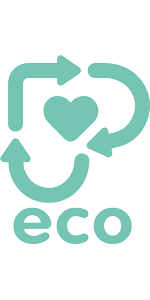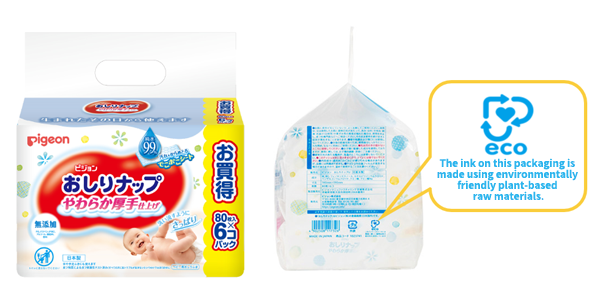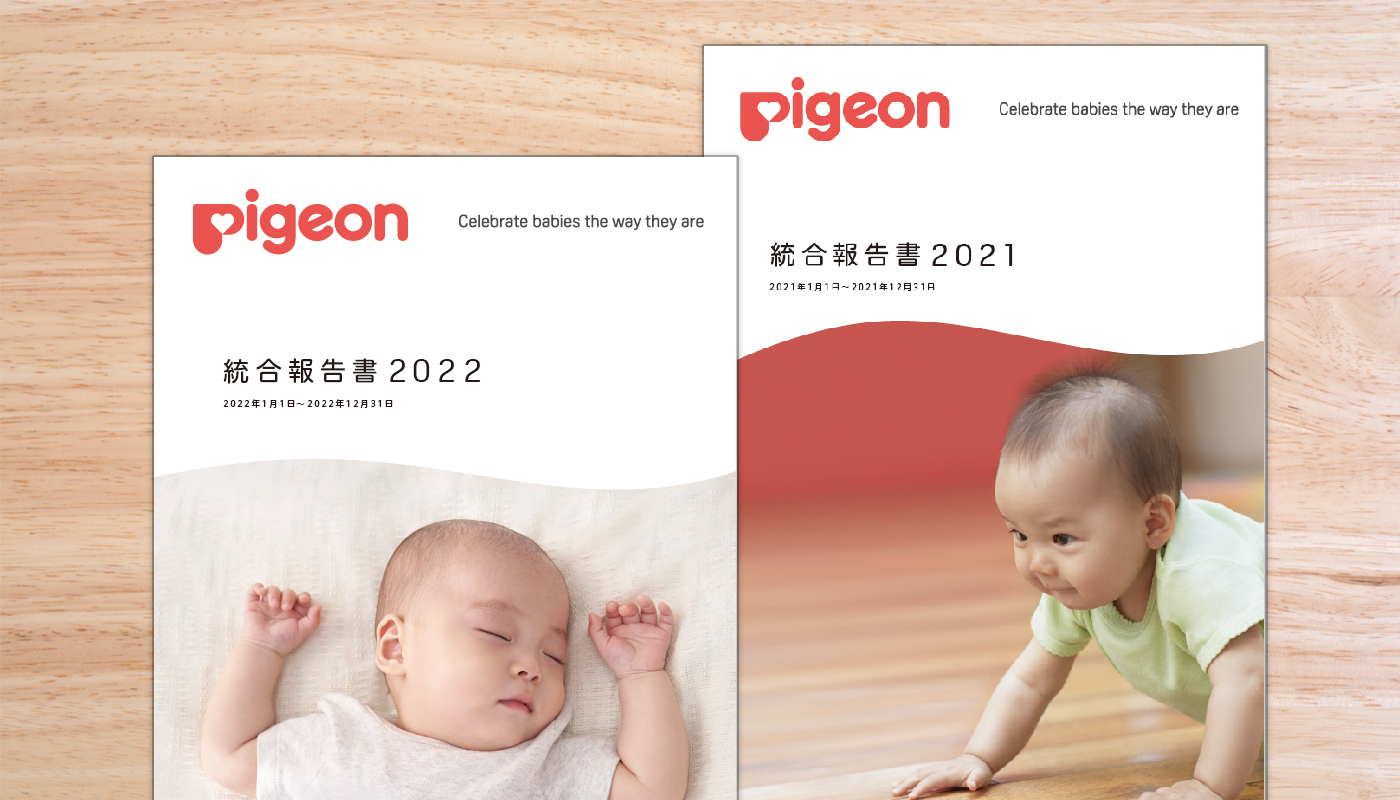Pigeon’s Sustainable Development Policy calls for “monozukuri for the future.” In order to preserve the environment so that babies born today can enjoy health and happiness decades from now, we engage in monozukuri (manufacturing) with an eye toward resolving environmental problems such as global warming, marine plastic waste, and resource depletion.
The Pigeon Eco-Label
To assist customers in Japan seeking to choose greener products, in February 2021 we launched the Pigeon Eco-Label. The Pigeon Eco-Label is displayed on the packaging of products that meet our Pigeon Eco-Label Standards. Our goal is to place the Pigeon Eco-Label on all our baby and maternity products sold in Japan by 2025.
The Pigeon Eco-Label’s design is based on the Pigeon logo, a “P” consisting of one heart embracing another to represent mother and child. For the Pigeon Eco-Label, the outer heart is made up of recycling arrows, representing a sustainable, recycling-oriented society. Caring for the global environment is part of our efforts to deliver love to people everywhere through products and services.
-

Eco-Label
-

Display example
Pigeon Eco-Label Standards
The Pigeon Eco-Label Standards are based on a life-cycle assessment (LCA) that quantifies environmental impact at every stage of the product life cycle: materials procurement, manufacturing, distribution, use, and disposal. Products which meet one or more of the criteria below are eligible for the Pigeon Eco-Label.
| Phase | Criterion |
|---|---|
| 1. Procurement of raw materials | 1-a. Products that use at least 10% plant derived materials |
1-b. Products that at least 10% sustainable raw materials |
|
| 2. Manufacturing | 2-a. Products manufactured using reduced electrical power in comparison with a conventional ?product |
2-b. Products manufactured using reduced water in comparison with a conventional product |
|
2-c. Products manufactured using reduced chemicals in comparison with a conventional product |
|
2-d. Products generating reduced waste in the manufacturing process in comparison with a conventional product |
|
| 3. Distribution | 3-a. Products with 10% or greater improvement in compactness than a conventional product |
3-b. Products with 10% or greater reduction in weight than a conventional product |
|
| 4. Use | 4-a. Products with 10% or greater reduction in energy consumption during use than a conventional product |
4-b. Products with 10% or greater reduction in water consumption during use than a conventional product |
|
| 5. Disposal | 5-a. Products with 10% or greater reduction in packaging materials than a conventional product |
5-b. Refill products whose containers offer 50% or greater reduction in weight in comparison with the original container |
|
5-c. Products whose waste is easier to sort components than a conventional product |
| Phase | Criterion |
|---|---|
| 1. Procurement of raw materials | 1-a. Products that use at least 10% plant derived materials |
1-b. Products that at least 10% sustainable raw materials |
|
| 2. Manufacturing | 2-a. Products manufactured using reduced electrical power in comparison with a conventional ?product |
2-b. Products manufactured using reduced water in comparison with a conventional product |
|
2-c. Products manufactured using reduced chemicals in comparison with a conventional product |
|
2-d. Products generating reduced waste in the manufacturing process in comparison with a conventional product |
|
| 3. Distribution | 3-a. Products with 10% or greater improvement in compactness than a conventional product |
3-b. Products with 10% or greater reduction in weight than a conventional product |
|
| 4. Use | 4-a. Products with 10% or greater reduction in energy consumption during use than a conventional product |
4-b. Products with 10% or greater reduction in water consumption during use than a conventional product |
|
| 5. Disposal | 5-a. Products with 10% or greater reduction in packaging materials than a conventional product |
5-b. Refill products whose containers offer 50% or greater reduction in weight in comparison with the original container |
|
5-c. Products whose waste is easier to sort components than a conventional product |
·Conventional products are either existing Pigeon products or representative Pigeon products sold concurrently (or a competitor’s product if Pigeon does not offer the product).
·Existing products that already satisfy the above criteria will be affixed with the Eco-Label in succession as packaging is replaced.
·Products that satisfy the above criteria and carry the certification logos of outside organizations may carry only the certification logos of said outside organizations, depending on space available on the packaging.
Pigeon Package Act 2025
To reduce the environmental impact of product packaging, we launched the Pigeon Package Act 2025 project in February 2021. We have set quantitative annual goals toward our objective of ensuring that all product packaging meets the Pigeon Eco-Label Standards by 2025, and are taking action accordingly.
Our Progress
In fiscal 2021, the number of products with packaging that meets the Pigeon Eco-Label Standards reached 34% of all eligible products.
We are aiming for 100% by FY2025 and will continue to work toward this goal through various green measures.












